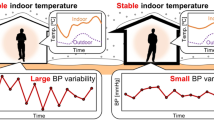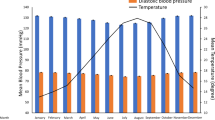Abstract
Higher morning blood pressure (BP) surge is a risk factor for cardiovascular disease independent of 24-h mean BP. Although low outdoor temperatures are associated with higher morning BP surges (MBPSs), the influence of indoor temperature and ambient temperatures (temperature while indoors or temperature while outdoors) on MBPS remains unclear. Such information may help prevent excess winter mortality. We simultaneously measured indoor temperatures (living room and bedroom), ambulatory BP and physical activity using wrist actigraphy for 768 person-days during winter and spring/fall in 192 participants (mean age, 69.9 years). Although the indoor and outdoor temperatures showed a strong correlation during periods of moderate temperature (range: 9.8 to 27.7 °C, rp=0.84), the correlation decreased during periods of lower outdoor temperatures (range: −3.37 to 9.73 °C, rp=0.28). In univariate and multivariate analyses, models with ambient temperatures showed the best goodness of fit (lowest Akaike’s information criterion (AIC)) followed by models with indoor temperatures and those with outdoor temperatures (AIC: ambient<indoor<outdoor temperature). A multivariate linear mixed-effect regression model showed that a 1 °C decrease in the ambient temperature was significantly associated with a 0.44 mm Hg increase in the sleep-trough MBPS and a 0.52 mm Hg increase in the prewaking BP surge. This was independent of potential confounders, including physical activity.
This is a preview of subscription content, access via your institution
Access options
Subscribe to this journal
Receive 12 digital issues and online access to articles
$119.00 per year
only $9.92 per issue
Buy this article
- Purchase on Springer Link
- Instant access to full article PDF
Prices may be subject to local taxes which are calculated during checkout


Similar content being viewed by others
References
Wolf K, Schneider A, Breitner S, von Klot S, Meisinger C, Cyrys J et al. Air temperature and the occurrence of myocardial infarction in Augsburg, Germany. Circulation 2009; 120 (9): 735–742.
Arntz HR, Willich SN, Schreiber C, Bru¨ggemann T, Stern R, Schultheiß HP . Diurnal, weekly and seasonal variation of sudden death. Population-based analysis of 24061 consecutive cases. Eur Heart J 2000; 21: 315–320.
Oberg AL, Ferguson JA, Mclntyre LM, Horner RD . Incidence of stroke and season of the year: evidence of an association. Am J Epidemiol 2000; 152: 558–564.
Turin TC, Kita Y, Murakami Y, Rumana N, Sugihara H, Morita Y et al. Higher stroke incidence in the spring season regardless of conventional risk factors: Takashima Stroke Registry, Japan, 1988-2001. Stroke 2008; 39 (3): 745–752.
Stergiou GS . Parallel morning and evening surge in stroke onset, blood pressure, and physical activity. Stroke 2002; 33 (6): 1480–1486.
Cohen MC, Rohtla KM, Lavery CE, Muller JE, Mittleman MA . Meta-analysis of the morning excess of acute myocardial infarction and sudden cardiac death. Am J Cardiol 1997; 79 (11): 1512–1516.
Modesti PA, Morabito M, Bertolozzi I, Massetti L, Panci G, Lumachi C et al. Weather-related changes in 24-hour blood pressure profile: effects of age and implications for hypertension management. Hypertension 2006; 47 (2): 155–161.
Kario K, Pickering TG, Umeda Y, Hoshide S, Hoshide Y, Morinari M et al. Morning surge in blood pressure as a predictor of silent and clinical cerebrovascular disease in elderly hypertensives: a prospective study. Circulation 2003; 107 (10): 1401–1406.
Stolarz-Skrzypek K, Thijs L, Richart T, Li Y, Hansen TW, Boggia J et al. Blood pressure variability in relation to outcome in the international database of ambulatory blood pressure in relation to cardiovascular outcome. Hypertens Res 2010; 33 (8): 757–766.
Kario KSK, Pickering TG . Clinical implication of morning blood pressure surge in hypertension. J Cardiovasc Pharmacol 2003; 42 (Suppl 1): s87–s91.
Kario K . Morning surge in blood pressure and cardiovascular risk: evidence and perspectives. Hypertension 2010; 56 (5): 765–773.
Murakami S, Otsuka K, Kono T, Soyama A, Umeda T, Yamamoto N et al. Impact of outdoor temperature on prewaking morning surge and nocturnal decline in blood pressure in a Japanese population. Hypertens Res 2011; 34 (1): 70–73.
Saeki K, Obayashi K, Iwamoto J, Tanaka Y, Tanaka N, Takata S et al. Influence of room heating on ambulatory blood pressure in winter: a randomised controlled study. J Epidemiol Community Health 2013; 67 (6): 484–490.
Leary AC, Strunthers AD, Donnan PT, macDonald TM, Murphy MB . The morning surge in blood pressure and heart rate is dependent on levels of physical activity after waking. J Hypertens 2002; 20: 865–870.
Goldwin J, Pearce V, Taylor R, Read K, Powers S . Seasonal cold and circadian changes in blood pressure and physical activity in young and elderly people. Age Ageing 2001; 30: 311–317.
Li Y, Thijs L, Hansen TW, Kikuya M, Boggia J, Richart T et al. Prognostic value of the morning blood pressure surge in 5645 subjects from 8 populations. Hypertension 2010; 55 (4): 1040–1048.
Respironics MM Actiwatch Comunication and sleep analysis software instruction manual 2006.
Group TE . Cold exposure and winter mortality from ischaemic heart disease, cerebrovascular disease, respiratory disease, and all causes in warm and cold regions of Europe. Lancet 1997; 349 (9062): 1341–1346.
Healy JD . Excess winter mortality in Europe: a cross country analysis identifying key risk factors. J Epidemiol Community Health 2003; 57 (10): 784–789.
Alylin P, Morris S, Wakefield J, Grossinho A, Jarup L, Elliott P . Temperature, housing, deprivation and their relationship to excess winter mortality in Great Britain, 1986–1996. Int J Epidemiol 2001; 30 (5): 1100–1108.
Wilson TE, Sauder CL, Kearney ML, Kuipers NT, Leuenberger UA, Monahan KD et al. Skin-surface cooling elicits peripheral and visceral vasoconstriction in humans. J Appl Physiol 2007; 103: 1257–1262.
Holowatz LA, Kenney WL . Peripheral mechanisms of thermoregulatory control of skin blood flow in aged humans. J Appl Physiol 2010; 109: 1538–1544.
Kristal-Boneh E, Harari G, Green MS, Ribak J . Summer-winter variation in 24 h ambulatory blood pressure. Blood Pressure Monitoring 1996; 1: 87–94.
Hayashi T, Ohshige K, Sawai A, Yamasue K, Tochikubo O . Seasonal influence on blood pressure in elderly normotensive subjects. Hypertens Res 2008; 31: 569–574.
Keatinge WR, Donaldoson GC, Cordioli E, Martinelli M, Kunst AE, mackenbach JP et al. Heat related mortality in warm and cold region of Europe: observational study. BMJ 2000; 321: 670–673.
Curriero F, Heiner K, Samet J, Zeger S, Strug L, Patz J . Temperature and mortality in 11 cities of the eastern United States. Am J Epidemiol 2002; 155: 80–87.
Ganguli MC, Grimm RH, Svendsen KH, Flack JM, Grandits GA, Elmer PJ . Higher education and income are related to a better Na:K ratio in blacks: baseline results of the Treatment of Mild Hypertension Study (TOMHS) data. Am J Hypertens 1997; 10: 979–984.
Cozier YC, Palmer JR, Horton NJ, Fredman L, Wise LA, Rosenberg L . Relation between neighborhood median housing value and hypertension risk among black women in the United States. Am J Public Health 2007; 97 (4): 718–724.
Calvo C, Hermida RC, Ayala DE, Lopez JE, Fernandez JR, Dominguez MJ et al. The 'ABPM effect' gradually decreases but does not disappear in successive sessions of ambulatory monitoring. J Hypertens 2003; 21 (12): 2265–2273.
Hess KL, Wilson TE, Sauder CL, Gao Z, Ray CA, Monahan KD . Aging affects the cardiovascular responses to cold stress in humans. J Appl Physiol 2009; 107: 1076–1082.
Neutel JM, Schumacher H, Gosse P, Lacourciere Y, Williams B . Magnitude of the early morning blood pressure surge in untreated hypertensive patients: a pooled analysis. Int J Clin Pract 2008; 62 (11): 1654–1663.
Stergiou GS, Mastorantonakis SE, Roussias LG . Morning blood pressure surge: the reliability of different definitions. Hypertens Res 2008; 31 (8): 1589–1594.
Eguchi K, Hoshide S, Hoshide Y, Ishikawa S, Shimada K, Kario K . Reproducibility of ambulatory blood pressure in treated and untreated hypertensive patients. J Hypertens 2010; 28 (5): 918–924.
The National Nutrition Survey 2010, http://www.mhlw.go.jp/bunya/kenkou/eiyou/h22-houkoku.html accessed 30 January 2013.
Ancoli-Israel S, Cole R, Alessi C, Chambers M, Moorcroft W, Pollak Cp . The role of actigraphy in the study of sleep and circadian rhythms. Sleep 2003; 26: 342–392.
Meltzer LJ, Walsh CM, Traylor J, Westin AM . Direct comparison of two new actigraphs and polysomnography in children and adolescents. Sleep 2012; 35 (1): 159–166.
Acknowledgements
We are indebted to all the participants of this study. We thank Sachiko Uemura, Naomi Takenaka and Shoichi Takamiya for their valuable support during data collection and analysis. This work was supported by grants for the Department of Indoor Environmental Medicine, Nara Medical University; Scientific Research from the Ministry of Education, Culture, Sports, Science and Technology; Mitsui Sumitomo Insurance Welfare Foundation; Meiji Yasuda Life Foundation of Health and Welfare; Osaka Gas Group Welfare Foundation; Japan Diabetes Foundation; and Japan Science and Technology Agency.
Author information
Authors and Affiliations
Corresponding author
Ethics declarations
Competing interests
The authors declare no conflict of interest.
Rights and permissions
About this article
Cite this article
Saeki, K., Obayashi, K., Iwamoto, J. et al. The relationship between indoor, outdoor and ambient temperatures and morning BP surges from inter-seasonally repeated measurements. J Hum Hypertens 28, 482–488 (2014). https://doi.org/10.1038/jhh.2014.4
Received:
Revised:
Accepted:
Published:
Issue Date:
DOI: https://doi.org/10.1038/jhh.2014.4
Keywords
This article is cited by
-
Estimating cardiovascular health gains from eradicating indoor cold in Australia
Environmental Health (2022)
-
Ambient temperature variability and blood pressure in a prospective cohort of 50,000 Chinese adults
Journal of Human Hypertension (2022)
-
Temperature, cardiovascular mortality, and the role of hypertension and renin–angiotensin–aldosterone axis in seasonal adversity: a narrative review
Journal of Human Hypertension (2022)
-
The relationship between home blood pressure measurement and room temperature in a Japanese general population
Hypertension Research (2021)
-
The Interaction Effects of Meteorological Factors and Air Pollution on the Development of Acute Coronary Syndrome
Scientific Reports (2017)



